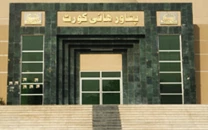Reinterpreting law: ‘Flawed’, ‘outdated’ master plan to be amended, says Elahi
CDA chief says plan is not based on ground realities; sources hint at land grabbers behind the scenes

The capital city’s civic agency boss has declared Islamabad’s original master plan outdated and vowed to bring amendments to it.
“A new strategic plan needs to be devised instead of relying on half-century old document to meet the modern needs,” he said while addressing a press conference at his office on Tuesday.
While residents may wonder why the original plan needed continuous changes, environmentalists are concerned that the civic agency’s lopsided idea of development has already devoured many green areas.
Islamabad’s master plan was made by a Greek firm Konstantinos Apostolos Doxiadis, in 1960, which has undergone many changes and been violated by influential real estate developers continually during the city’s lifetime.
Addressing a press conference after a CDA Board meeting, CDA Chairman Imtiaz Inayat Elahi said that a draft of amendments in the CDA Ordinance 1960 has been prepared to cope with the present challenges.
“That will enable the civic agency to develop the city and provide civic amenities to the residents, he said.
He denied that the new ordinance was being introduced to counter the Supreme Court’s decisions on joint ventures and package deals with locals for acquiring land.
The new ordinance would enable the CDA to deacquire land. The draft bill of the new ordinance has already been sent to the Cabinet Division. The bill proposes 10 years imprisonment for occupation CDA land illegally.
“There were numerous flaws and anomalies in the master plan,” he added.
He claimed that ground realities were ignored while preparing the document. Responding to another question, the CDA boss opined that the civic agency deviated from the plan because numerous flaws existed in it.
He said that in view of changing realities, the authority’s top management brought positive changes in the plan, adding that realising the prevailing financial crunch, the CDA adopted a policy of austerity while spending money from the national exchequer.
He said that despite ups and downs, the CDA achieved its desired goals successfully. He said that Islamabad was known as a green city around the globe. “After getting more powers, we will maintain the beauty of the capital.”
According to reports, President Asif Ali Zardari will soon issue the new ordinance.
The bill will be tabled in the National Assembly for approval. The Supreme Court recently declared the CDA’s joint venture with Multi Professional Cooperating Housing Society in sector E-11 null and void.
The apex court also asked CDA to retrieve its land from the possession of influential land grabbers without extending any kind of relief or package deal.
However, media reports have cited officials of the authority hinting that powerful land grabbers were behind this fresh move to stop CDA from retrieving its valuable land. Without negating those reports, the CDA chairman said that strategic planning in the contemporary situation was necessary.
Changes made in the master plan
1964– The first amendment in the master plan was made when the location of Quaid-i-Azam University was shifted from the National Park area southeast of Rawal Lake to northeast of Diplomatic Enclave.
1964– Sector E-11 was to be developed for low-income private and government housing. But CDA was stopped from acquiring the area in consideration of the location of Golra shrine there.
1969– Extension of commercial area and the alignment of its Central Business District along Jinnah Avenue, known as Blue Area, up to F-10 was allowed
1969– Sector F-9, which was originally designated as residential area, was converted into a park - the Fatima Jinnah Park
1969– the rural periphery of Islamabad along Kahuta Road was turned into an industrial triangle for medium scale industries.
1972– the federal government converted the whole E-10 sector, half of which had to be preserved as green area, into a residential area, relocating the army’s General Headquarters (GHQ) there.
1973– Sectors E-8, E-9 and E-10, originally meant for public and government residential facilities, were designated for the armed forces residential-cum official facilities
1974– Pakistan Institute of Medical Sciences (Pims), originally proposed close to the National Institute of Health (NIH) near Chak Shahzad, was shifted to its present location in Sector G-8/3
1974– Half the H-sectors was designated as green belt and the other half for special institutions. But, the upper half of H-8 was given to different institutions, H-9 converted into orchard, H-10 and H-12 given to private educational institutes.
1975– Originally, the Exhibition Area, including the present Lok Versa, was part of the National Park Area near village Tarlai Kalan. But they were shifted to their present locations south of Shakarparian Park.
1985– Gen Ziaul Haq approved the setting up of the Fecto cement plant in the Margalla Hills National Park area in violation of the master plan
1988– Sector I-8, designated as Transportation Centre, was converted into a residential sector.
1988– QAU’s original site was allocated to Zoo-cum-Botanical Garden.
1991– Half of the I-14, I-15 and I-16 sectors were originally planned for industrial units and the other half for housing their workers, but the entire three sectors were converted into residential areas
1995– Land where the Convention Centre and Serena Hotel stand today was designated in the master plan as green area and right of way of the Kashmir Highway.
1992–- Zones-II and V, which were part of the Islamabad rural periphery, were given to developing new residential, institutional and industrial series 17 was identified and housing was allowed in Zone-V.
Published in The Express Tribune, August 24th, 2011.



















COMMENTS
Comments are moderated and generally will be posted if they are on-topic and not abusive.
For more information, please see our Comments FAQ